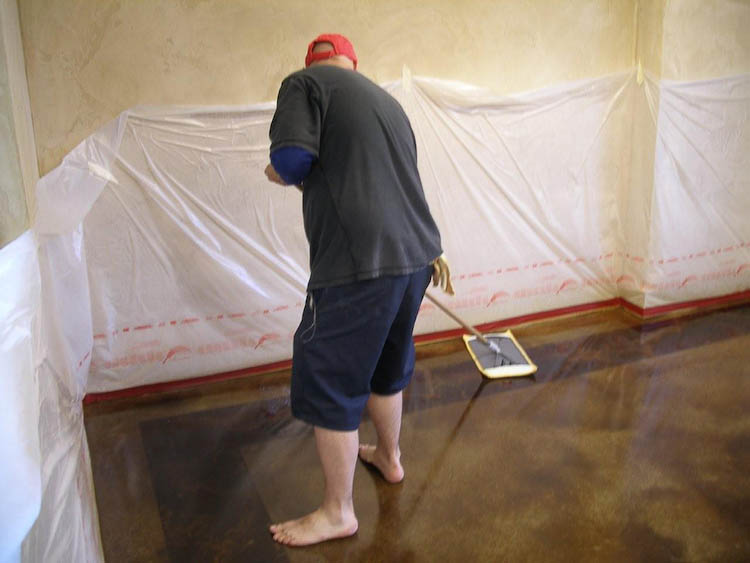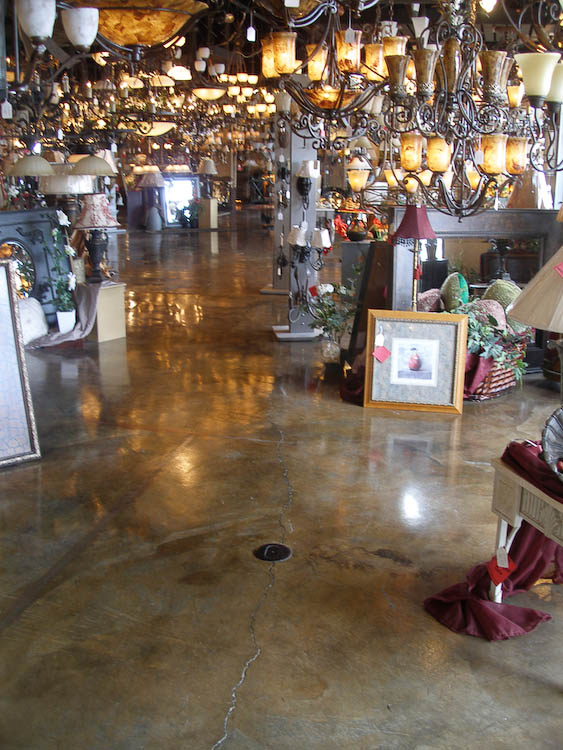Why Hire Us?
Staining Bedroom Floors under Carpet
Post-recession, our most frequent job is not to stain a nice new slab of concrete, but to stain the concrete in the bedrooms of a home that has stained floors throughout the rest of the house. The homeowner thought that concrete in the bedrooms would feel “cold” when they got out of bed in the morning, so those floors were carpeted. It is now ten years later and the owners love the easy maintenance of their stained concrete and hate dragging out the vacuum and spot-cleaning the shabby carpets in their bedrooms.
 The first photo shows what we usually encounter on these floors. The house painters had a field day knowing that the bedroom floors would be hidden. They not only oversprayed the walls about two feet out, but they threw down the wooden baseboards for the whole house and sprayed them with enamel paint using the bedroom slab as a dropcloth. This means that we will spend 15 or 20 labor hours removing two kinds of latex paint before we can begin to clean and fill the holes along the walls where the carpet tack-strip was nailed into the slab.
The first photo shows what we usually encounter on these floors. The house painters had a field day knowing that the bedroom floors would be hidden. They not only oversprayed the walls about two feet out, but they threw down the wooden baseboards for the whole house and sprayed them with enamel paint using the bedroom slab as a dropcloth. This means that we will spend 15 or 20 labor hours removing two kinds of latex paint before we can begin to clean and fill the holes along the walls where the carpet tack-strip was nailed into the slab.
If we are lucky, most of the glue used to hold the foam carpet pad in place will come up during our paint stripping, since it was squirted on top of the paint layers. When every speck of foreign material is removed from the slab, we can do a final scrub with TriSodium Phosphate to remove our strippers, then rinse well and let the floors dry for staining. Since labor is costly and our materials relatively cheap, staining an older slab will often cost twice what it would have cost to stain the bedrooms when the house was built. 
Why not use a grinder to remove paint and glue? The friction can drive glue even further into the pores and shot-blasting gives a “sugary” texture to the floor once it is sealed. Our goal is to make your concrete slab look like stone or marble. We do not want to destroy the natural variegations in real, cured concrete. Acid stains bring out the character of the slab, so we do not conceal flaws with even-colored overlayments, either.
Faux Real is old-fashioned in the sense that we labor mightily to achieve the best aesthetic result. This is slower and more labor-intensive than most stainers want to work. We believe that the original concrete slab, done correctly, will also have a more durable finish and last for decades longer than a quick-fix remodel.
Staining Floors under Tile
Floors under vinyl composition tile (VCT) do not present as much of a problem as concrete under ceramic tile. VCT is held down with lots of glue, but if the glue is over ten years old, and yellow, most of it can be scraped off. What is left in the cracks and depressions will usually give way after a 15-minute soak with chemicals.


We recently had to clean the floors of an old warehouse where the VCT had been put down in the 1940’s or 50’s. That glue was black and tarlike. The stripping process was arduous and messy, but our chemicals melted the glue quite well.
Ceramic tile, on the other hand, will permanently change the color of the slab under it. We had a client who worked relentlessly for a month to chip off and sand away the “Thinset” (a cementitious material used in setting tile). There was nothing wrong with his work. What he did not know was that ceramic tile causes the slab to cure differently under the grout layer than under the solid tile, creating a permanent “tile shadow” acrossthe floor. Those who try“grinding through it” will find that the shadow penetrates the entire depth of the slab.



We went ahead and stained those floors and laid thin plastic into the wet stain to create what I hoped would be a concealing pattern. The living room was under carpet, so that turned out fine. But the kitchen and hallways had marked tile patterns. We spent many hours faux painting out the most pronounced lines and since then we have refused to stain ceramic-tiled floors.
Kitchen Remodels


Kitchen remodels are popular these days. Most often the floors were stained AFTER cabinets and counters were installed, so removing them leaves large areas of gray concrete. In both of these remodeling jobs the slab had been divided into squares with ¾” troweled-in joints. We had to stain the gray concrete squares to match the rest of the floors, but also to fill the joints with patching materials and faux paint it to match the older, exposed grout in the rest of the kitchen.
The kitchen gets the most intense traffic in the house, especially in front of the sink and stove. Those areas are usually gray with wear and need to be painted to match the edges. (Unlike the hidden areas, these cannot be stained, since they have had layers of clear sealer applied, which repels all stain).



A kitchen remodel like this might take us two or three days, but that is much more reasonable than stripping all the other floors in the house and starting from scratch with new staining, which is what most stainers, who cannot match colors with faux painting, will recommend.


































































































































































































































































